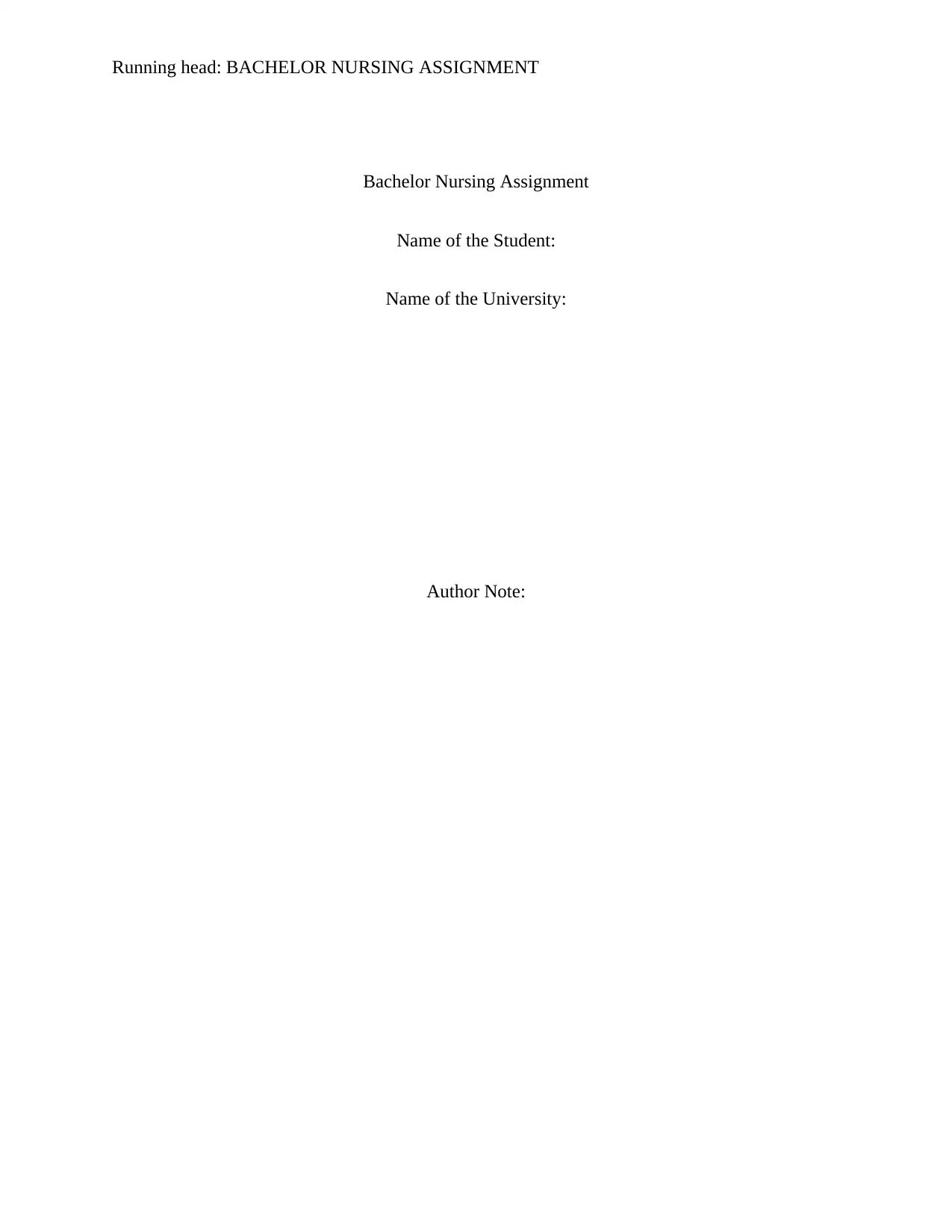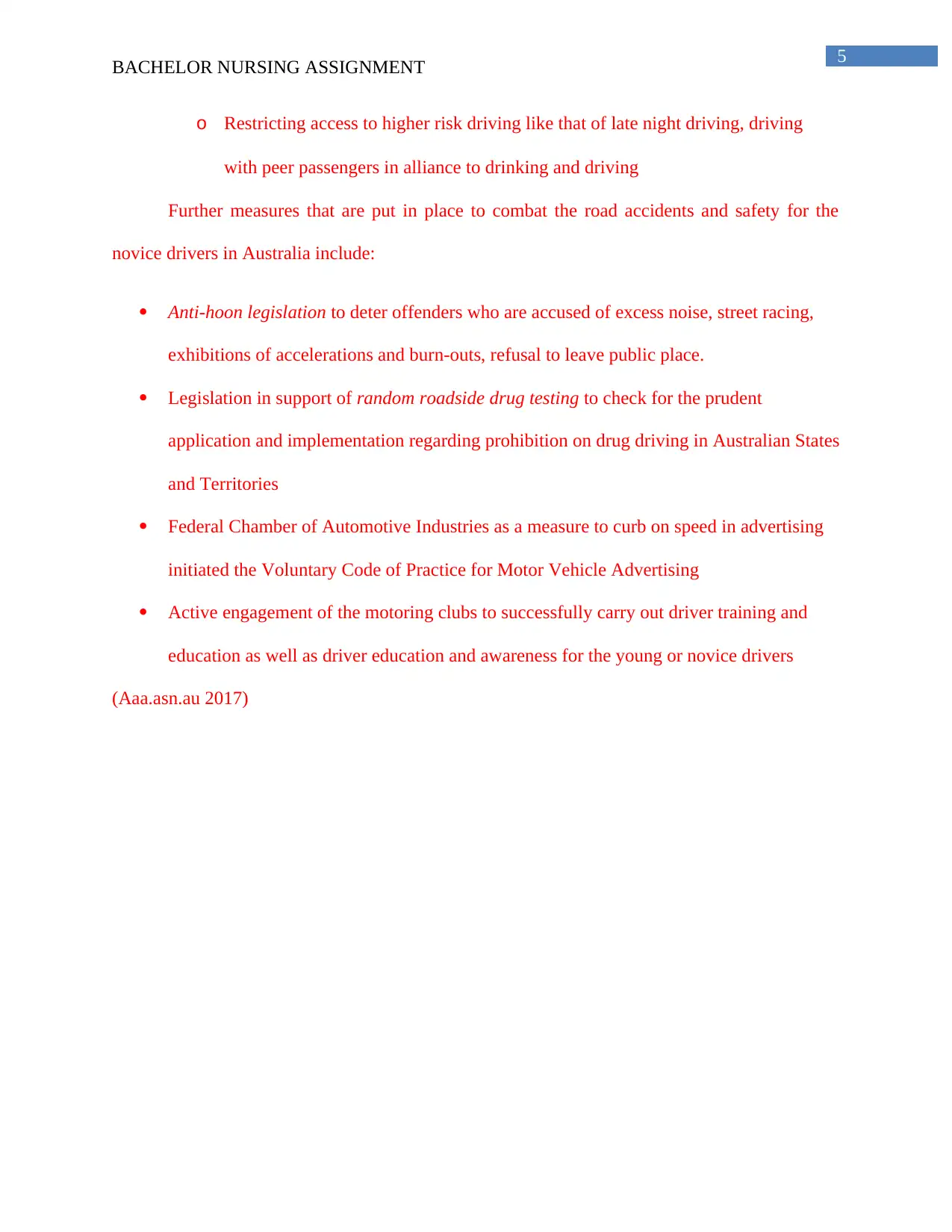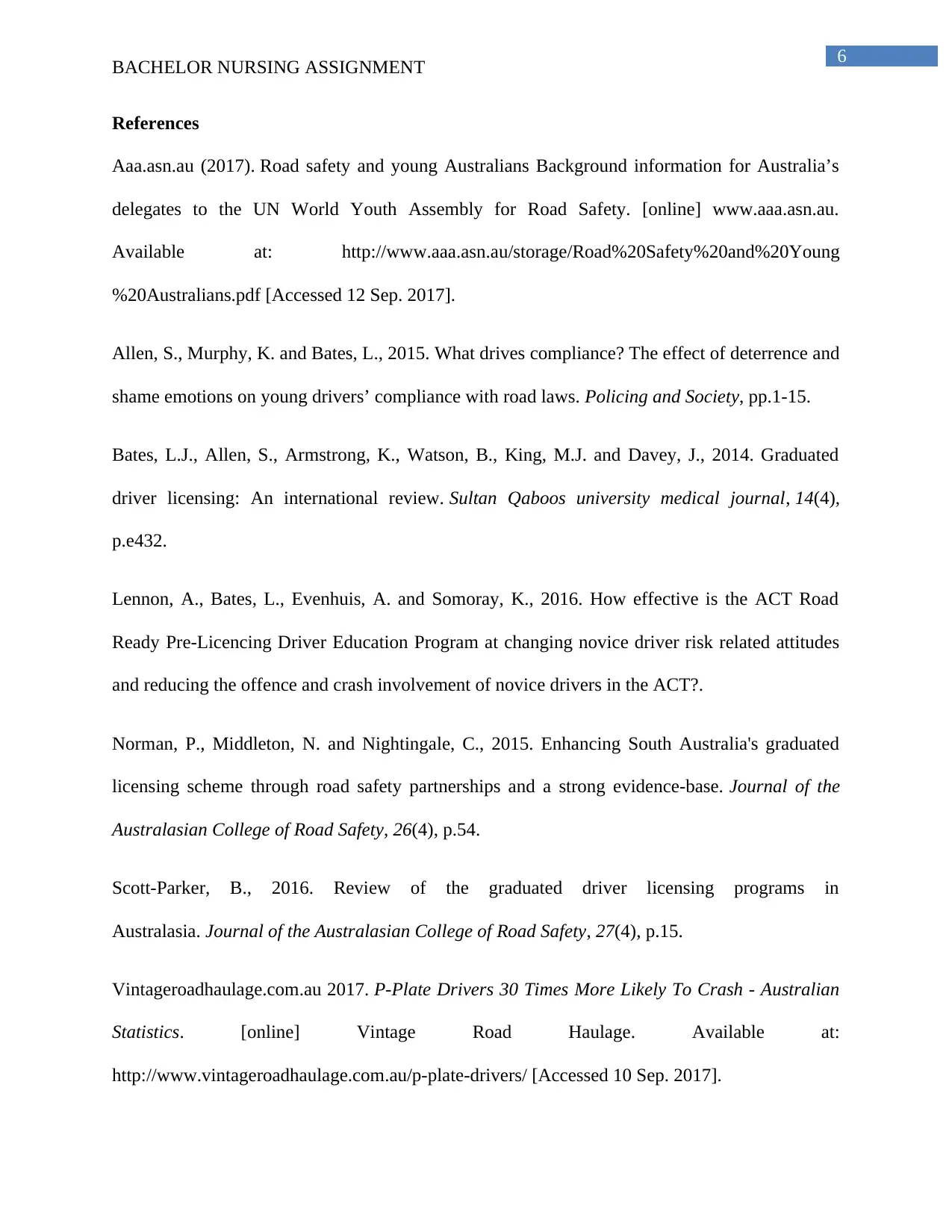An Examination of Road Safety and P Plate Driver Accidents
VerifiedAdded on 2019/11/08
|8
|1568
|325
Report
AI Summary
This report examines the road safety challenges associated with probationary ('P' plate) drivers, focusing on their increased risk of accidents compared to experienced drivers. It outlines the regulations and restrictions imposed on P plate drivers, including zero blood alcohol content, speed limits, and mobile phone use prohibitions. The report explores factors contributing to accidents, such as drinking and driving, drug use, and distractions, and discusses current strategies like Graduated Driver Licensing (GDL) programs. It also evaluates the effectiveness of programs like Road Ready and proposes additional measures to reduce risks, including stricter speed limits, passenger restrictions, and repeated driving skill assessments. The report highlights the importance of community and industry participation in promoting safety for novice drivers and emphasizes the role of anti-hoon legislation and random roadside drug testing in preventing accidents. It concludes by advocating for national strategies to address road safety concerns for P plate drivers, including educational programs and public awareness campaigns. The report uses several academic sources to support the findings and recommendations.

Running head: BACHELOR NURSING ASSIGNMENT
Bachelor Nursing Assignment
Name of the Student:
Name of the University:
Author Note:
Bachelor Nursing Assignment
Name of the Student:
Name of the University:
Author Note:
Paraphrase This Document
Need a fresh take? Get an instant paraphrase of this document with our AI Paraphraser

1
BACHELOR NURSING ASSIGNMENT
‘P’ Plate Drivers and Fatal Traffic Accidents
Who are ‘P’ plate drivers?
‘P’ plate drivers refer to the probationary drivers who are at the initial stages of driving and have
been licensed recently to authorize them for driving cars. Licenses are issued to them following
proper driving test to assess their skills in driving. ‘P’ license is usually issued for 1 year and it is
expected on the part of the drivers to follow definite road safety guidelines. Zero percentage of
blood alcohol content (BAC) must be noted for these drivers while driving. Driving speed limit
below 80 km/hr is applicable for ‘P’ plate drivers.
Actions meant for ‘P’ plate drivers
The permission to hit the road all by oneself is granted through issuing of the probationary
license. Statistically, the probationary or ‘P’ plate drivers are more likely to cause road accidents
as opposed to their experienced counterparts. It has been categorically mentioned in one report
that in case of solo drive performance by a ‘P’ plate driver, there remains 30 times chances of
causing crashes and 3 times more likely to suffer injury or encounter death in contrast to the
experienced drivers (Vintageroadhaulage.com.au, 2017).
Types of ‘P’ plate drivers
P1 or red plate is valid for duration of 12 months during the time of probationary driving.
P2 or green plate is applicable at the start of 12 months since when P1 license is granted to the
driver and lasts for a minimum of three years. Measures to improve the graduated licensing
scheme have been introduced in South Austrlia (Norman, Middleton and Nightingale 2015).
BACHELOR NURSING ASSIGNMENT
‘P’ Plate Drivers and Fatal Traffic Accidents
Who are ‘P’ plate drivers?
‘P’ plate drivers refer to the probationary drivers who are at the initial stages of driving and have
been licensed recently to authorize them for driving cars. Licenses are issued to them following
proper driving test to assess their skills in driving. ‘P’ license is usually issued for 1 year and it is
expected on the part of the drivers to follow definite road safety guidelines. Zero percentage of
blood alcohol content (BAC) must be noted for these drivers while driving. Driving speed limit
below 80 km/hr is applicable for ‘P’ plate drivers.
Actions meant for ‘P’ plate drivers
The permission to hit the road all by oneself is granted through issuing of the probationary
license. Statistically, the probationary or ‘P’ plate drivers are more likely to cause road accidents
as opposed to their experienced counterparts. It has been categorically mentioned in one report
that in case of solo drive performance by a ‘P’ plate driver, there remains 30 times chances of
causing crashes and 3 times more likely to suffer injury or encounter death in contrast to the
experienced drivers (Vintageroadhaulage.com.au, 2017).
Types of ‘P’ plate drivers
P1 or red plate is valid for duration of 12 months during the time of probationary driving.
P2 or green plate is applicable at the start of 12 months since when P1 license is granted to the
driver and lasts for a minimum of three years. Measures to improve the graduated licensing
scheme have been introduced in South Austrlia (Norman, Middleton and Nightingale 2015).

2
BACHELOR NURSING ASSIGNMENT
Rules and Regulations for ‘P’ plate drivers
Specific instructions and guidelines are provided for the drivers regarding display of ‘P’ plate
Peer passenger restrictions are also applicable that need to be stringently followed. It is
mandatory to display the plate for all times during driving. Carrying of license is must while
driving. Use of mobile phones or any sort of messaging devices is strictly prohibited during
driving. There should be no alcohol or illicit drugs inside the body while driving. Cancellation of
license might be undertaken in case of violation of the rules and penalty may be imposed
accordingly.
Factors affecting road accidents during driving
Drinking and driving- Consumption of alcohol that reduces the cognitive functioning and cause
diminution of alertness. Intake of drugs that leads to euphoria thereby causing derangement of
the emotional responses might be held responsible for causing road accidents. Talking on mobile
phones while driving and driving in dim light at night hours might also pose challenges and
culminate in causing road accidents (Scott-Parker 2016).
Measures to reduce crashes due to driving/ Current Strategies available
Graduate Driver Learning (GDL) refers to a comprehensive program introduced with the aim of
gradually increasing exposure of the new drivers to more complicated driving situations. The
program comprises of learner, provisional and open license phases. Learner license phase refers
to the condition in which the novice driver is exposed to lower risk situations for the sake of
obtaining practical learning experience. Learner license entitles the new driver to learn under the
vigilance of supervisors, might delay the licensure and mandate the desired work hours necessary
BACHELOR NURSING ASSIGNMENT
Rules and Regulations for ‘P’ plate drivers
Specific instructions and guidelines are provided for the drivers regarding display of ‘P’ plate
Peer passenger restrictions are also applicable that need to be stringently followed. It is
mandatory to display the plate for all times during driving. Carrying of license is must while
driving. Use of mobile phones or any sort of messaging devices is strictly prohibited during
driving. There should be no alcohol or illicit drugs inside the body while driving. Cancellation of
license might be undertaken in case of violation of the rules and penalty may be imposed
accordingly.
Factors affecting road accidents during driving
Drinking and driving- Consumption of alcohol that reduces the cognitive functioning and cause
diminution of alertness. Intake of drugs that leads to euphoria thereby causing derangement of
the emotional responses might be held responsible for causing road accidents. Talking on mobile
phones while driving and driving in dim light at night hours might also pose challenges and
culminate in causing road accidents (Scott-Parker 2016).
Measures to reduce crashes due to driving/ Current Strategies available
Graduate Driver Learning (GDL) refers to a comprehensive program introduced with the aim of
gradually increasing exposure of the new drivers to more complicated driving situations. The
program comprises of learner, provisional and open license phases. Learner license phase refers
to the condition in which the novice driver is exposed to lower risk situations for the sake of
obtaining practical learning experience. Learner license entitles the new driver to learn under the
vigilance of supervisors, might delay the licensure and mandate the desired work hours necessary
⊘ This is a preview!⊘
Do you want full access?
Subscribe today to unlock all pages.

Trusted by 1+ million students worldwide

3
BACHELOR NURSING ASSIGNMENT
to go to the next level alongside encouraging parental involvement during the entire process.
Provisional license phase is meant for imposing restrictions thereby mitigating the chances of
exposure to highly risky situations. Reduction of crash risk is fostered through implementation of
GDL with parental involvement as a crucial and integral step in the process (Bates et al. 2014)
Effectiveness of the programs undertaken
Road Ready Pre-Licensing Driver Education Program
Attitudinal and belief related factors that have been detected to accentuate risk during the
provisional license period among the novice drivers irrespective of their age was addressed by
virtue of this program. Effectiveness of the ACT Road Ready pre-licensing driver education
program directed to alter the novice driver risk related attitudes and practices in conjunction with
mitigating the offence and road crashes was confirmed through evaluation study (Lennon et al.
2016).
Driver’s Compliance to Road Safety
GDL is mainly targeted for the young drivers to reduce the incidences of fatalities and injuries
due to road accidents. Compliance to the restriction imposed by virtue of GDL is low for young
drivers. Empirical findings have compared the effects of both formal as well as informal
deterrence with regards to compliance behaviors in the ‘P’ plate drivers by referring to
Australian survey data. Results depicted that informal deterrence instead of formal deterrence
has the potential of generating feelings of shame due to wrongdoing thereby relating to the
young driver’s compliance with road rules (Allen, Murphy and Bates 2015).
BACHELOR NURSING ASSIGNMENT
to go to the next level alongside encouraging parental involvement during the entire process.
Provisional license phase is meant for imposing restrictions thereby mitigating the chances of
exposure to highly risky situations. Reduction of crash risk is fostered through implementation of
GDL with parental involvement as a crucial and integral step in the process (Bates et al. 2014)
Effectiveness of the programs undertaken
Road Ready Pre-Licensing Driver Education Program
Attitudinal and belief related factors that have been detected to accentuate risk during the
provisional license period among the novice drivers irrespective of their age was addressed by
virtue of this program. Effectiveness of the ACT Road Ready pre-licensing driver education
program directed to alter the novice driver risk related attitudes and practices in conjunction with
mitigating the offence and road crashes was confirmed through evaluation study (Lennon et al.
2016).
Driver’s Compliance to Road Safety
GDL is mainly targeted for the young drivers to reduce the incidences of fatalities and injuries
due to road accidents. Compliance to the restriction imposed by virtue of GDL is low for young
drivers. Empirical findings have compared the effects of both formal as well as informal
deterrence with regards to compliance behaviors in the ‘P’ plate drivers by referring to
Australian survey data. Results depicted that informal deterrence instead of formal deterrence
has the potential of generating feelings of shame due to wrongdoing thereby relating to the
young driver’s compliance with road rules (Allen, Murphy and Bates 2015).
Paraphrase This Document
Need a fresh take? Get an instant paraphrase of this document with our AI Paraphraser

4
BACHELOR NURSING ASSIGNMENT
Proposed Measures to reduce risk for ‘P’ plate drivers
Setting speed limits while driving and avoiding night time driving
Refraining from driving being intoxicated due to drinking of alcohol or taking other
drugs
Carrying only the approved number of passengers while driving
No representation of risky behaviors such as that of racing and others
Conducting repeated appraisals of driving skills and knowledge
Purchasing a car having good feedbacks and review
Considering the fact that the young ones who are categorized as ‘P’ plate drivers are most
prone to result in causing road accidents in Australian domicile, a national strategy has been
beckoned by the concerned authority to mitigate the issue. The recent action plan has take into
account certain broad safety measures encompassing safe roadside practices, improvement
directed in terms of rendering protection for the vehicle occupant in conjunction with emphasis
laid upon drink an drug driving has been put in force. The actions and strategies that have been
improvised and implemented include:
Implementation and evaluation of best practice educational programs as well as graduate
licensing systems concerning the novice drivers
Promotion of community in addition to industry participation in case of chief graduate
licensing initiatives
To increase public awareness regarding the safety benefits for the novice drivers
emphasizing on:
o Lending extensive support before permitting solo driving
BACHELOR NURSING ASSIGNMENT
Proposed Measures to reduce risk for ‘P’ plate drivers
Setting speed limits while driving and avoiding night time driving
Refraining from driving being intoxicated due to drinking of alcohol or taking other
drugs
Carrying only the approved number of passengers while driving
No representation of risky behaviors such as that of racing and others
Conducting repeated appraisals of driving skills and knowledge
Purchasing a car having good feedbacks and review
Considering the fact that the young ones who are categorized as ‘P’ plate drivers are most
prone to result in causing road accidents in Australian domicile, a national strategy has been
beckoned by the concerned authority to mitigate the issue. The recent action plan has take into
account certain broad safety measures encompassing safe roadside practices, improvement
directed in terms of rendering protection for the vehicle occupant in conjunction with emphasis
laid upon drink an drug driving has been put in force. The actions and strategies that have been
improvised and implemented include:
Implementation and evaluation of best practice educational programs as well as graduate
licensing systems concerning the novice drivers
Promotion of community in addition to industry participation in case of chief graduate
licensing initiatives
To increase public awareness regarding the safety benefits for the novice drivers
emphasizing on:
o Lending extensive support before permitting solo driving

5
BACHELOR NURSING ASSIGNMENT
o Restricting access to higher risk driving like that of late night driving, driving
with peer passengers in alliance to drinking and driving
Further measures that are put in place to combat the road accidents and safety for the
novice drivers in Australia include:
Anti-hoon legislation to deter offenders who are accused of excess noise, street racing,
exhibitions of accelerations and burn-outs, refusal to leave public place.
Legislation in support of random roadside drug testing to check for the prudent
application and implementation regarding prohibition on drug driving in Australian States
and Territories
Federal Chamber of Automotive Industries as a measure to curb on speed in advertising
initiated the Voluntary Code of Practice for Motor Vehicle Advertising
Active engagement of the motoring clubs to successfully carry out driver training and
education as well as driver education and awareness for the young or novice drivers
(Aaa.asn.au 2017)
BACHELOR NURSING ASSIGNMENT
o Restricting access to higher risk driving like that of late night driving, driving
with peer passengers in alliance to drinking and driving
Further measures that are put in place to combat the road accidents and safety for the
novice drivers in Australia include:
Anti-hoon legislation to deter offenders who are accused of excess noise, street racing,
exhibitions of accelerations and burn-outs, refusal to leave public place.
Legislation in support of random roadside drug testing to check for the prudent
application and implementation regarding prohibition on drug driving in Australian States
and Territories
Federal Chamber of Automotive Industries as a measure to curb on speed in advertising
initiated the Voluntary Code of Practice for Motor Vehicle Advertising
Active engagement of the motoring clubs to successfully carry out driver training and
education as well as driver education and awareness for the young or novice drivers
(Aaa.asn.au 2017)
⊘ This is a preview!⊘
Do you want full access?
Subscribe today to unlock all pages.

Trusted by 1+ million students worldwide

6
BACHELOR NURSING ASSIGNMENT
References
Aaa.asn.au (2017). Road safety and young Australians Background information for Australia’s
delegates to the UN World Youth Assembly for Road Safety. [online] www.aaa.asn.au.
Available at: http://www.aaa.asn.au/storage/Road%20Safety%20and%20Young
%20Australians.pdf [Accessed 12 Sep. 2017].
Allen, S., Murphy, K. and Bates, L., 2015. What drives compliance? The effect of deterrence and
shame emotions on young drivers’ compliance with road laws. Policing and Society, pp.1-15.
Bates, L.J., Allen, S., Armstrong, K., Watson, B., King, M.J. and Davey, J., 2014. Graduated
driver licensing: An international review. Sultan Qaboos university medical journal, 14(4),
p.e432.
Lennon, A., Bates, L., Evenhuis, A. and Somoray, K., 2016. How effective is the ACT Road
Ready Pre-Licencing Driver Education Program at changing novice driver risk related attitudes
and reducing the offence and crash involvement of novice drivers in the ACT?.
Norman, P., Middleton, N. and Nightingale, C., 2015. Enhancing South Australia's graduated
licensing scheme through road safety partnerships and a strong evidence-base. Journal of the
Australasian College of Road Safety, 26(4), p.54.
Scott-Parker, B., 2016. Review of the graduated driver licensing programs in
Australasia. Journal of the Australasian College of Road Safety, 27(4), p.15.
Vintageroadhaulage.com.au 2017. P-Plate Drivers 30 Times More Likely To Crash - Australian
Statistics. [online] Vintage Road Haulage. Available at:
http://www.vintageroadhaulage.com.au/p-plate-drivers/ [Accessed 10 Sep. 2017].
BACHELOR NURSING ASSIGNMENT
References
Aaa.asn.au (2017). Road safety and young Australians Background information for Australia’s
delegates to the UN World Youth Assembly for Road Safety. [online] www.aaa.asn.au.
Available at: http://www.aaa.asn.au/storage/Road%20Safety%20and%20Young
%20Australians.pdf [Accessed 12 Sep. 2017].
Allen, S., Murphy, K. and Bates, L., 2015. What drives compliance? The effect of deterrence and
shame emotions on young drivers’ compliance with road laws. Policing and Society, pp.1-15.
Bates, L.J., Allen, S., Armstrong, K., Watson, B., King, M.J. and Davey, J., 2014. Graduated
driver licensing: An international review. Sultan Qaboos university medical journal, 14(4),
p.e432.
Lennon, A., Bates, L., Evenhuis, A. and Somoray, K., 2016. How effective is the ACT Road
Ready Pre-Licencing Driver Education Program at changing novice driver risk related attitudes
and reducing the offence and crash involvement of novice drivers in the ACT?.
Norman, P., Middleton, N. and Nightingale, C., 2015. Enhancing South Australia's graduated
licensing scheme through road safety partnerships and a strong evidence-base. Journal of the
Australasian College of Road Safety, 26(4), p.54.
Scott-Parker, B., 2016. Review of the graduated driver licensing programs in
Australasia. Journal of the Australasian College of Road Safety, 27(4), p.15.
Vintageroadhaulage.com.au 2017. P-Plate Drivers 30 Times More Likely To Crash - Australian
Statistics. [online] Vintage Road Haulage. Available at:
http://www.vintageroadhaulage.com.au/p-plate-drivers/ [Accessed 10 Sep. 2017].
Paraphrase This Document
Need a fresh take? Get an instant paraphrase of this document with our AI Paraphraser

7
BACHELOR NURSING ASSIGNMENT
BACHELOR NURSING ASSIGNMENT
1 out of 8
Your All-in-One AI-Powered Toolkit for Academic Success.
+13062052269
info@desklib.com
Available 24*7 on WhatsApp / Email
![[object Object]](/_next/static/media/star-bottom.7253800d.svg)
Unlock your academic potential
Copyright © 2020–2025 A2Z Services. All Rights Reserved. Developed and managed by ZUCOL.